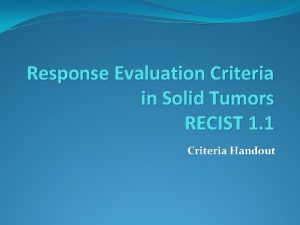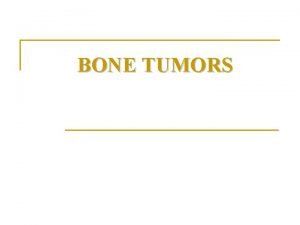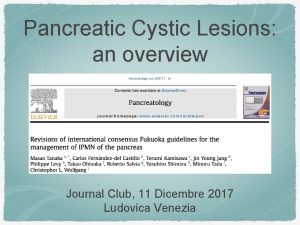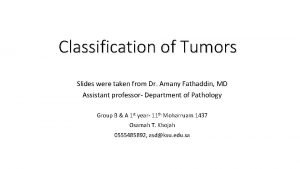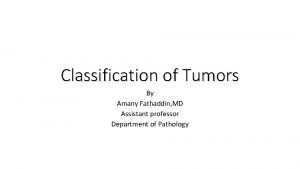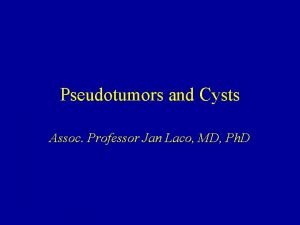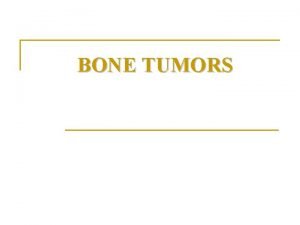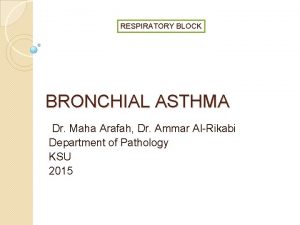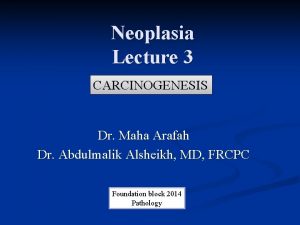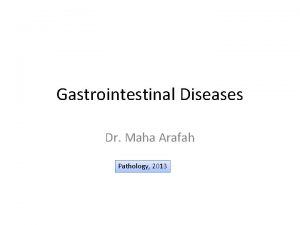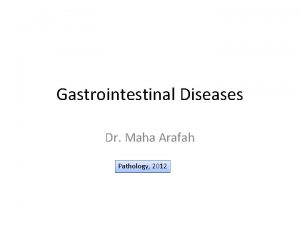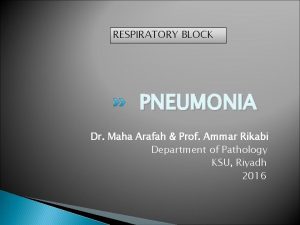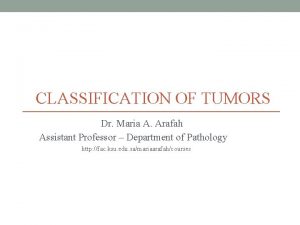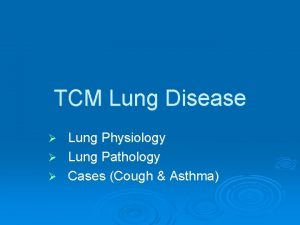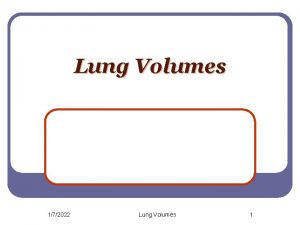TUMORS OF THE LUNG Dr Maha Arafah and





































- Slides: 37

TUMORS OF THE LUNG Dr. Maha Arafah and Prof. Ammar Rikabi Department of Pathology KSU, Riyadh Respiratory block Pathology Lec 5 2020

Objectives Know the epidemiology of lung cancer Be aware of the new classification of bronchogenic carcinoma which include: squamous carcinoma, adenocarcinoma, small cell and large cell (anaplastic) carcinomas. Understand the predisposing factors of bronchogenic carcinoma. Understands the clinical features and gross pathology of bronchogenic carcinoma. Know the precursors of squamous carcinoma (squamous dysplasia) and adenocarcinoma (adenocarcinoma in situ and atypical adenomatous hyperplasia). Have a basic knowledge about neuroendocrine tumours with special emphasis on small cell carcinoma and bronchial carcinoid. Be aware that the lung is a frequent site for metastatic neoplasm.

Lung Tumors Most lung tumors are malignant. Primary lung cancer is a common disease BUT metastatic tumors are more common than the primary tumors. The most common benign lesions are hamartomas.

Epidemiology 1. Primary lung cancer is the most common fatal cancer in both men and women worldwide. a. Accounts for >30% of cancer deaths in men b. Accounts for >25% of cancer deaths in women 2. Incidence of lung cancer is declining in men but increasing in women. 3. Peak incidence is at 55 to 65 years of age.

Classification of bronchogenic carcinoma Malignant epithelial tumors/ bronchogenic carcinoma I. Non-Small Cell Lung Carcinoma (NSCC) 1. Squamous cell carcinoma 2. Adenocarcinoma 3. Large cell carcinoma II. Small cell lung carcinoma (SCC) III. Combine patterns IV. Carcinoid tumor V. Others Ø Malignant mesothelial tumor Malignant mesothelioma Miscellaneous malignant tumor - Carcinosarcoma - Pulmonary blastoma - Melanoma - Lymphoma - Others Epithelial Fibrous (spindle cell) Biphasic

Classification of Malignant epithelial tumors of lung I. Non-Small Cell Lung Carcinoma (NSCC) (70%-75%) 1. Squamous cell carcinoma (25%-35%) 2. Adenocarcinoma, including bronchioloalveolar carcinoma (30%-35%). 3. Large cell carcinoma (10%-15%). II. Small cell lung carcinoma (SCC) (20%-25%). III. Combine patterns (5%-10%). - Most frequent patterns: - Mixed squamous cell ca and adenocarcinoma. - Mixed squamous cell ca and SCLC. IV. Carcinoid tumors V. Others Both small cell carcinoma and carcinoids are neuroendocrine tumors as both arise from the neurendocrine cells normally present in the lung

Bronchogenic carcinoma is a malignant neoplasm of the lung arising from the epithelium of the lung. is a common cause of cancer death in both men and women. For therapeutic purposes, bronchogenic carcinoma are classified into: 1. 2. Non- Small cell lung carcinoma (NSCC) which includes squamous cell, adenocarcinomas, and large-cell carcinomas. Small cell lung carcinoma (SCC)

Bronchogenic carcinoma It is important to differentiated NSCC from SCC because treatment are different. NSCC therapy • • Surgical - offers the best chance for curing. Radiation - controls local disease. Radiation therapy is most commonly used to palliate symptoms. Chemotherapy – not effective. Immunotherapy SCC therapy Chemotherapy is very effective because small cell carcinomas are highly responsive to chemotherapy

Predisposing factors of bronchogenic carcinoma 1. Tobacco smoking: Some 85% of lung cancers occur in cigarette smokers. Most types are linked to cigarette smoking, but the strongest association is with squamous cell carcinoma and small cell carcinoma The nonsmoker who develops cancer of the lung usually has an adenocarcinoma. is directly proportional to the number of cigarettes smoked daily and the number of years of smoking. Cessation of cigarette smoking for at least 15 years brings the risk down. Passive smoking increases the risk to approximately twice than nonsmokers. Cigarette smokers show various histologic changes, including squamous metaplasia of the respiratory epithelium which may progress to dysplasia, carcinoma in situ and ultimately invasive carcinoma

Predisposing factors The risk of lung cancer is determined by the number of cigarettes smoked The risk is 20 to 40 times greater among habitual heavy smokers

Female smokers have a much greater risk of death from lung cancer and chronic obstructive lung disease in recent years than female smokers 20 or 40 years ago, reflecting changes in smoking behavior according to an article published in New England Journal of Medicine. Female smokers today smoke more like men than women in previous generations, beginning earlier in adolescence and, until recently, smoking more cigarettes per day. The Cancer Letter • Jan. 25, 2013

Predisposing factors of bronchogenic carcinoma Other causes 2. 3. 4. 5. 6. Radiation: . All types of radiation may be carcinogenic and increase the risk of developing lung cancer. Tradium and uranium workers are at risk Asbestos: increased incidence of cancer with asbestos exposure, especially in combination with cigarette smoking. Industrial exposure to nickel and chromates, coal, mustard gas, arsenic, iron etc. Air pollution: May play some role in increased incidence. Indoor air pollution especially by radon. Scarring: sometimes old infarcts, wounds, scar, granulomatous infections are associated with adenocarcinoma.

Precursor Lesions Three types of precursor epithelial lesions are recognized: (1) Squamous dysplasia and carcinoma in situ can lead to: Squamous cell carcinoma (2) Atypical adenomatous hyperplasia can lead to: Adenocarcinoma (3) Diffuse idiopathic pulmonary neuroendocrine cell hyperplasia can lead to: Neuroendocrine tumors It should be noted that the term "precursor" does not imply that progression to invasion will occur in all cases.

Squamous cell carcinoma Second most common bronchogenic carcinoma Strong association with smoking (25 times risk) Before Males>Females, now incidence in female rising because of smoking. This type of cancer is preceded by years of progressive mucosal changes of respiratory epithelium to squamous metaplasia to dysplasia to ca. in situ to invasive SCC. Sq. CC arise in the central airways (centrally located). So they appears as a hilar mass. Frequently cavitate Tumor cells secrete a parathyroid hormone (PTH)- like peptide leading to hypercalcemia. Poor prognosis

Squamous cell carcinoma (Sq. CC) Histologically, these tumors are graded according to degree of squamous differentiation and tumors ranges from: � well-differentiated squamous cell carcinoma (A), � moderately differentiated Sq. CC (B) to � poorly differentiated Sq. CC (C). A C B

Adenocarcinomas Adenocarcinomas is now the most frequent histologic subtype of bronchogenic carcinoma; more common in women. They do not have a clear link to smoking history They are classically peripheral tumors arising from the peripheral airways and alveoli.

Adenocarcinoma Precursor Lesions Atypical adenomatous hyperplasia is a small lesion (≤ 5 m) characterized by dysplastic pneumocytes lining alveolar walls that are mildly fibrotic Adenocarcinoma in situ; AIS (formerly called bronchioloalveolar carcinoma) is a lesion that is less than 3 m and is composed entirely of dysplastic cells growing along preexisting alveolar septae, no growth patterns other than lepidic and no feature of necrosis or invasion Minimally invasive adenocarcinoma of lung (MIA) ≤ 3 cm, describes small solitary adenocarcinomas with either pure lepidic growth or predominant lepidic growth with ≤ 5 mm of stromal invasion.

Atypical adenomatous hyperplasia Minimally invasive adenocarcinoma of lung Adenocarcinoma in situ (formerly called bronchioloalveolar carcinoma)

Adenocarcinoma in situ (formerly called bronchioloalveolar CA Malignant cells grow along alveolar septae referred to as adenocarcinoma in situ according to the new classification of lung cancers

Adenocarcinomas More common in patients under the age of 40, women and non-smokers. Tend to metastasize widely at early stage The hallmark of adenocarcinomas is the tendency to form glands that may or may not produce mucin. Peripheral adenocarcinomas are sometimes associated with pulmonary scars (from a previous pulmonary inflammation/infection) and therefore is also referred to as scar carcinoma. Rarely cavitate TTF 1

Adenocarcinoma Associated with hypertrophic pulmonary osteoarthropathy “Clubbing of the fingers”

Large Cell Carcinoma Frequency: 10 % strongly associated with smoking Large-cell carcinoma are usually located peripherally. These group of carcinomas are undifferentiated. They made up of large and anaplastic cells. They may exhibit neuroendocrine or glandular differentiation markers when studied by immunohistochemistry or electron microscopy. Poor prognosis.

Small cell carcinomas SCLC are a type neuroendocrine tumors arising from neuroendocrine cells. More common in men. Highly malignant and aggressive tumor, poor prognosis, rarely resectable. Strongly associated with cigarette smoking. 95% of patients are smokers Centrally located perihilar mass with early metastases (Early involvement of the hilar and mediastinal nodes) Chemotherapy responsive but recur invariably least likely form to be cured by surgery; usually already metastatic at diagnosis Ability to secrete a host of polypeptide hormones like ACTH (leading to Cushing’s syndrome), antidiuretic hormone (ADH), calcitonin, gastrinreleasing peptide and chromogranin. It may be associated with paraneoplastic syndrome e. g. Cushing’s and Eaton-Lambert syndrome

Eaton-Lambert syndrome is an autoimmune disease a disease in which the immune system attacks the body's own tissues. The attack occurs at the connection between nerve and muscle (the neuromuscular junction) and interferes with the ability of nerve cells to send signals to muscle cells.

Small cell carcinomas Microscopically composed of small, dark, round to oval, lymphocyte-like cells with little cytoplasm. Necrosis is invariably present Electron microscopy: dense-core neurosecretory granules.

Bronchogenic carcinoma site Central tumors Squamous cell CA Small cell CA Peripheral tumors Adenocarcinoma - bronchial derived - bronchioloalveolar ca Large cell carcinoma

Molecular genetics in lung cancer Most common oncogenes— KRAS, MYC family, HER-2/neu, BCL-2, EGFR, ROS 1 and ALK (epidermal growth factor receptor found in some cases of pulmonary adenocarcinoma, if certain mutation is positive, will respond to anti-tyrosin kinase) so on all cases of adenocarcinoma and SCC we do EGFR and if negative; ALK and ROS 1 are done b. Most common suppressor genes—p 53 (most common), RB 1 and p 16

Clinical features of bronchogenic carcinoma Can be silent or insidious lesions chronic cough and expectoration, hemoptysis, and bronchial obstruction, often with atelectasis. Hoarseness, chest pain, superior vena cava syndrome, pericardial or pleural effusion. Symptoms due to metastatic spread.

Clinical features: may also be manifest by the following a) b) c) d) e) f) g) h) Superior vena cava syndrome: invasion leads to obstruction of venous drainage which leads to dilation of veins in the upper part of the chest and neck resulting in swelling and cyanosis of the face, neck, and upper extremities Pancoast tumor (superior sulcus tumor): Apical neoplasms may invade the brachial sympathetic plexus to cause severe pain, numbness and weakness in the distribution of the ulnar nerve. The combination of clinical findings is known as Pancoast syndrome. Pancoast tumor is often accompanied by destruction of the first and second ribs and thoracic vertebrae lead to Pancoast (Horner) syndrome: invasion of the cervical thoracic sympathetic nerves and it leads to ipsilateral enophthalmos, miosis, ptosis, and facial anhidrosis in addition to numbness and weakness of the hand Hoarseness from recurrent laryngeal nerve paralysis Pleural effusion, often bloody with high fibrin and protein contents. Paraneoplastic syndrome

Complications of bronchogenic carcinoma Bronchiectasis Obstructive pneumonia Pleural effusion Superior vena cava syndrome Prognosis: NSCLC have a better prognosis than SCLC. Outlook is poor for most patients.

Paraneoplastic syndromes of lung cancer, are extrapulmonary, remote effects of tumors. 3% to 10% of lung cancers develop paraneoplastic syndromes. Small cell carcinomas ACTH (leading to Cushing's syndrome) ADH (water retention and hyponatremia) Squamous cell carcinomas may secrete parathyroid hormone-like peptide and prostaglandin E that lead to hypercalcemia Carcinoid tumors produce serotonin and bradykinin leading to carcinoid syndrome (flushing, wheezing, diarrhea, and cardiac valvular lesions) Adenocarcinomas can lead to hematologic manifestations Other endocrine syndromes associated with primary lung carcinomas e. g. gonadotrophin production leading to gynecomastia, calcitonin production leading to hypocalcemia and others: hyperglycemia, thyrotoxicosis, and skin pigmentation

Clinical features and complication of bronchogenic carcinoma

Spread of bronchogenic carcinoma 1. Lymphatic spread. * successive chains of nodes (scalene nodes). * involvement of the supraclavicular node (Virchow’s node). 2. Extend into the pericardial or pleural spaces. Infiltrate the superior vena cava. 3. A tumor may extend directly into the esophagus, producing obstruction, sometimes complicated by a fistula. 4. Phrenic nerve invasion usually causes diaphragmatic paralysis 5. May invade the brachial or cervical sympathetic plexus (Horner’s Syndrome). 6. Distant metastasis to liver (30 -50%), adrenals (>50%), brain (20%) and bone (20%).

Carcinoid tumor Carcinoid tumors of the lung are neuroendocrine neoplasms These neoplasms account for 2% of all primary lung cancers, It shows no sex predilection, and are not related to cigarette smoking or other environmental factor. Usually seen in adults Can be central or peripheral in location. Tumor cells produce serotonin and bradykinin leading to carcinoid syndrome Can occur in patients with Multiple Endocrine Neoplasia (MEN-I) Low malignancy, Often resectable and curable. Spreads by direct extension into adjacent tissue

Morphology of typical carcinoid tuomors Composed of uniform cuboidal cells that have regular round nuclei with few mitoses and little or no anaplasia. Electron microscopy: dense-core neurosecretory granules

Mesothelioma Malignant tumor of mesothelial cells lining the pleura Highly malignant neoplasm Most patients (70%) have a history of exposure to asbestos Smoking is not related to mesothelioma The average of patients with mesothelioma is 60 years. Pleural mesotheliomas tend to spread locally within the chest cavity, invading and compressing major structures. Metastases can occur to the lung parenchyma and mediastinal lymph nodes, as well as to extrathoracic sites e. g. liver, bones, peritoneum etc. Treatment is largely ineffective and prognosis is poor: few patients survive longer than 18 months after diagnosis

Carcinoma metastatic to the lung Pulmonary Metastases are More Common than Primary Lung Tumors Metastatic tumors in the lung are typically multiple and circumscribed. When large nodules are seen in the lungs radiologically, they are called cannon ball metastases. The common primary sites are the breast, stomach, pancreas, and colon.
 Attahiyat dua in english
Attahiyat dua in english Hikmah wukuf di arafah
Hikmah wukuf di arafah Ziarat arafah
Ziarat arafah Malignant and benign tumors
Malignant and benign tumors Prostate adenocarcinoma perineural invasion
Prostate adenocarcinoma perineural invasion Classification de robbins
Classification de robbins Ectocervix
Ectocervix Response evaluation criteria in solid tumors (recist)
Response evaluation criteria in solid tumors (recist) Chondrosarcoma
Chondrosarcoma Bone tumors
Bone tumors Spinal cord tumors
Spinal cord tumors Brain tumors
Brain tumors Acromely
Acromely Paresthiasis
Paresthiasis Exocrine tumors of pancreas
Exocrine tumors of pancreas Classification of tumors
Classification of tumors Classification of tumors
Classification of tumors Odontogenic tumors classification
Odontogenic tumors classification Enneking classification
Enneking classification Odontogenic tumors
Odontogenic tumors Classify odontogenic tumors
Classify odontogenic tumors Thyroid grading system
Thyroid grading system Maha anemi
Maha anemi Mikroanjiopati
Mikroanjiopati Maha khachab
Maha khachab Maha suci
Maha suci Ravana generation
Ravana generation Bertakwa kepada tuhan yang maha esa berarti
Bertakwa kepada tuhan yang maha esa berarti Allah memiliki sifat al matin artinya allah maha
Allah memiliki sifat al matin artinya allah maha Maha district 6
Maha district 6 Kisah 3 santri memotong ayam
Kisah 3 santri memotong ayam Maha shouman
Maha shouman Allah maha esa
Allah maha esa Katakanlah dialah allah yang maha esa
Katakanlah dialah allah yang maha esa Kailā maha
Kailā maha Ttp diagnostic criteria
Ttp diagnostic criteria Maha el keshawi
Maha el keshawi Maha ka matlab
Maha ka matlab







